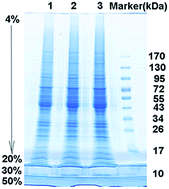SDS is widely used to treat proteins that are difficult to solubilize and digest and improve protein separation in SDS-PAGE. However, SDS interferes with subsequent analyses and needs to be removed prior to digestion and LC-MS/MS analysis, whereas the conventional SDS-PAGE lacks the ability to efficiently remove SDS and retain low-molecular-weight proteins and peptides. In the present work, we developed a wide-range gradient gel electrophoresis (WGGE) system in a vertical slab gel electrophoresis cell, which was primarily composed of a 4–20% continuous gradient polyacrylamide gel separation layer and two interception layers with even higher concentrations (30% and 50%, respectively). The main advantages of the system are simultaneously cleaning up SDS-solubilized samples, separating proteins and intercepting low-molecular-weight proteins and peptides, thereby simplifying experimental operation, improving protein recovery and enhancing the total efficiency of proteome analysis. Using this system, about 87.25% of SDS in the sample and gel was electrophoretically removed and a peptide with a molecular weight of 3.75 kDa was efficiently intercepted. Combined with CapLC-MS/MS, the WGGE system was applied to the analysis of rat liver membrane-enriched protein samples and the results indicated that the WGGE-based strategy is suitable for the identification of proteins varying in molecular weight, pI, hydrophobicity, etc., suggesting potential applications in global and comparative analyses of various proteomes.

